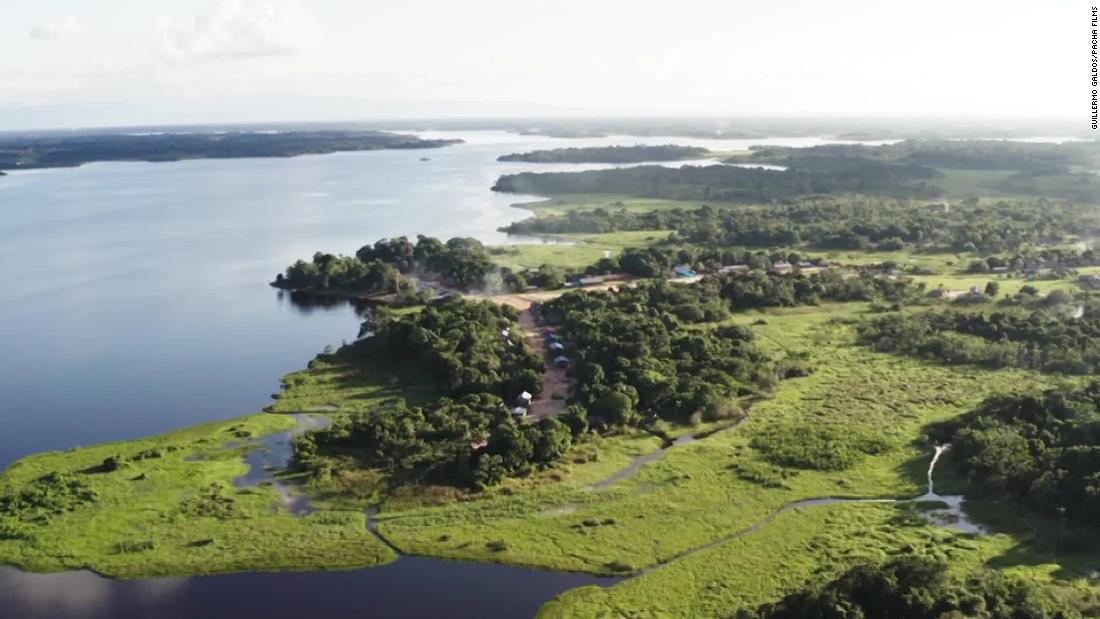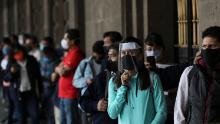
In the remote Shipibo village of Caimito, 80 percent of the community has shown symptoms of coronavirus, according to local nurse Elias Magin. The nearest hospital is an eight-hour boat ride away.
When we arrived in late May, a line of people snaked around a simple building with a makeshift sign declaring it the Puesto de Salud, or health clinic, for Caimito. It was only 10am and those who could walk were patiently waiting to get medical attention.
“In the past three days, we have run out of the medicine the government gave us,” Magin told us. “The only medicine we have left is for other conditions. I don’t even have any paracetamol.”
Visitors discouraged
Because of Covid-19, the Shipibo have discouraged visitors. But after I reached out to the leader of the Caimito community, Juan Carlos Mahua, he extended an invitation, as he wanted to highlight the devastating impact of the virus.
There is only one way of reaching Caimito, and that is via an eight-hour boat ride along the Ucayali River from the regional capital of Pucallpa, which is a further 18-hour car ride from Lima. Because of the national government’s lockdown on transport, we had to get special permission to take the river journey into the heart of the Amazon.
The further we pushed inland, the fewer people and the more wildlife we saw. We spotted a handful of boats and scattered villages along the river.
When we reached Caimito, Mahua and Magin were waiting on the river bank, surrounded by other local officials and warriors with bows and arrows. All were coughing and looking sick.
Greeting the village leader, I asked Mahua how he was doing. “Not very well,” he replied between coughing spells. He gestured to those around him, “We are all positive for Covid-19.”
Of the 750 people in this one community, about 80% are believed to be infected with Covid-19, based on their presenting symptoms, Magin said. At least four people have died.
When the virus first struck, the government-appointed doctor left Caimito as his contract had expired, leaving Magin in charge along with one other nurse and an assistant.
Magin himself was diagnosed with Covid-19 three days before our arrival, when a government team visited Caimito and administered tests to about 20 people. They also left supplies that quickly ran out.
Because the clinic is so short-staffed, Magin has continued to work despite his diagnosis.
Peru’s health ministry did not respond to a request for comment.
Bustling clinic and house calls
During our visit, the clinic was bustling. A patient was being weighed. Another patient breathed in deeply while a medical assistant listened to his chest with a stethoscope. More like a simple doctor’s office than a critical care unit, this outpost was never meant to handle a crisis like the coronavirus. There are no respirators, no ICU beds, no advanced equipment or technology.
After seeing patients all morning in the clinic, Magin went into the community to check on people who were too sick to leave their homes.
One of his patients was Reiner Fernandez, 32, who had been sick with Covid-19 symptoms for the previous two weeks and was too weak to walk to the clinic.
Magin put on protective gear before entering the thatched roof hut where Fernandez lived with his wife and four children. The inside was spartan, with few furnishings and the floor made of uneven wooden planks. There was no running water.
Fernandez was lying on the floor, tucked underneath a makeshift tent, his breathing labored, too weak to even stand. “My heart is agitated. It feels like it wants to stop,” Fernandez told Magin.
His wife Karina stood close by as the nurse tended to her husband. She bit her lip and paced.
Fernandez had lost 17 pounds since he got sick. He still had a fever. But if things got worse, it would be nearly impossible to find urgent medical attention — the nearest hospital was in Pucallpa, a city overwhelmed by the virus.
Little help in the nearest hospital
It’s not just the deep Amazon that’s in trouble — the entire Ucayali region has been hard-hit by the coronavirus. At Pucallpa’s main hospital, workers have had to clear away bodies of people who died outside the doors. Inside, there are not enough staff to care for the sick.
“It’s been very hard to see people dying,” said Dr. Ricardo Muñante, head of the Covid Ward at Pucallpa Hospital. “To see people asking for help and not being able to do anything.”
The staff work 12-18 hour shifts, wearing full protective gear in temperatures that can hit 100 degrees Fahrenheit. There are no ICU beds left here, and only 1 out of 10 patients in critical condition is expected to survive, Muñante said.
This is the story playing out all across towns and cities in Peru, which has been struck with over 257,000 cases of the virus and at least 8,000 deaths nationwide.
In the beginning, the Peruvian government’s response to the outbreak was swift and sober. Shortly after the first cases were reported in the capital of Lima, President Martin Vizcarra announced a nationwide lockdown on March 15.
But as the lockdown stretched on, many of the more than 70% of people that work in the informal economy in Peru suddenly found themselves with no jobs, no money, and little to no food. And even though there were strict restrictions against travel, hundreds of thousands of migrant workers had little choice but to travel from the larger cities like Lima and Pucallpa by foot and by boat back to their home villages and towns.
Some brought Covid-19 home with them. Others brought it back as they had to travel to nearby cities to pick up the Covid-support payments of $225 the government made available to low income households.
There is no bank in Caimito, or in other remote Amazon towns like it. So, residents had to travel as far as Pucallpa to get their money.
Last week, Vizcarra acknowledged the government’s shortcomings in responding to the pandemic, saying on June 15 there were “many administrative and bureaucratic failures.”
Social distancing still a distant idea
In Caimito, it falls on residents to implement the measures themselves. I saw no signs that social distancing and shelter-in-place restrictions were being enforced by local authorities, and Magin said locals were still not taking the virus as seriously as they should.
One morning during our visit, Magin carried a microphone and amplifier to the center of the village. Taking a deep breath, he broadcast his message:
“We have not defeated this virus,” he said. “And yet we are not social distancing. We are still going to church, playing sports and volleyball,” his words reverberating through the loudspeakers attached to a post high above his head.
“And if we don’t change our ways — then we are going to keep dying.”
A few weeks later, I was again in touch with Magin. He said the situation has stabilized in Caimito, that the isolation has helped contain the virus and that a community group had traveled to Pucallpa to pick up medicine from the regional ministry of health.
Although he’s still weak, Reiner Fernandez is doing better now, Magin said. And there have been no new deaths.

Malvagio fanatico dei social media. Pensatore hardcore. Pop cultureaholic. Organizzatore. Esperto di alcolici. Appassionato di cibo. Sostenitore di Twitter per tutta la vita









